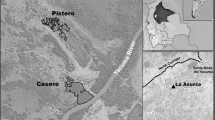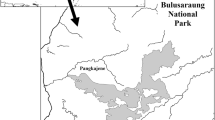Abstract
Forest fragmentation and deforestation are major threats to primates at a global scale. The survival of primates in forest fragments largely depends on their behavioral and dietary flexibility, as well as their ability to use a modified matrix in anthropogenic landscapes, hence the importance of determining these ecological parameters in habitats with strong anthropic interventions. This paper aims to describe the activity budget and diet of two groups of the Colombian night monkey (Aotus lemurinus) and to estimate their home range in two peri-urban forest fragments in the city of Manizales, Colombia. We combined scan sampling and handheld GPS fixes in order to determine the behavioral, dietary and spatial patterns of the study groups. Night monkeys spent most of their time resting and traveling and were mainly frugivorous relying on at least 26 plant species in their diet. The most consumed plants included Persea americana, Cecropia angustifolia, Musa x paradisiaca, Cecropia telenitida, and Croton cf. mutisianus. Two of these plants are cultivated species and can provide important resources for populations in small forest fragments. Home range sizes were estimated at 1.7 to 1.8 hectares, using a grid count method. Our results suggest the potential adaptability that these primates have when exposed to anthropogenic habitat disturbances and habitat degradation. Nonetheless, future studies should evaluate the influence of demographic factors and resource availability on the behavioral, dietary and spatial patterns of A. lemurinus in peri-urban forests, in order to further understand their ability to cope with the pervasive processes of habitat fragmentation in the northern Andes.


Similar content being viewed by others
References
Altmann J (1974) Observational study of behavior: sampling methods. Behaviour 49:227–266. https://doi.org/10.1163/156853974x00534
Araújo AJB, Liesenfeld MVA (2017) Ocorrência de primatas não humanos no ambiente urbano de Cruzeiro do Sul, Acre, Brasil. Biodivers Br 7:113–122. https://doi.org/10.6084/m9.figshare.9436190
Boyle SA, Lourenço WC, Da Silva LR, Smith AT (2009) Home range estimates vary with sample size and methods. Folia Primatol 80:33–42. https://doi.org/10.1159/000201092
Castaño JH, Cardona DM (2005) Presencia del mono nocturno andino (Aotus lemurinus I. Geoffroy-St. Hilaire, 1843) en fragmentos de bosque de la cuenca media del Río Cauca. Bol Cient Mus His Nat 9:111–120
Castaño JH, Ramirez DC, Botero JE (2010) Ecología del mono mocturno andino (Aotus lemurinus) en fragmentos de bosque subandinos de Colombia. In: Pereira-Bengoa V, Stevenson PR, Bueno ML, Nassar F (eds) Primatología en Colombia. Fundación Universitaria San Martín, Bogotá, Avance al principio del milenio, pp 69–90
Chao A (1984) Nonparametric estimation of the number of classes in a population. Scand J Stat 11:265–270
Chauhan A, Pirta RS (2010) Socio-ecology of two species of non-human primates, Rhesus Monkey (Macaca mulatta) and Hanuman Langur (Semnopithecus entellus), in Shimla, Himachal Pradesh. J Hum Ecol 30:171–177. https://doi.org/10.1080/09709274.2010.11906286
Chaves ÓM, Bicca-Marques JC, Chapman CA (2018) Quantity and quality of seed dispersal by a large arboreal frugivore in small and large Atlantic forest fragments. PLoS ONE 13:e0193660. https://doi.org/10.1371/journal.pone.0193660
Cifuentes PA, Londoño JP (2010) Análisis del crecimiento urbano: Una aproximación al estudio de los factores de crecimiento de la ciudad de Manizales como aporte a la planificación. Gest Ambient 13:53–66
Cincotta RP, Wisnewski J, Engelman R (2000) Human population in the biodiversity hotspots. Nature 404:990–992. https://doi.org/10.1038/35010105
Cowlishaw G, Dunbar RI (2000) Primate conservation biology. University of Chicago Press, Chicago
Defler TR (2010) Historia natural de los primates colombianos. Universidad Nacional de Colombia, Bogotá
Defler TR, Bueno ML (2007) Aotus diversity and the species problem. Primate Conserv 22:55–70. https://doi.org/10.1896/052.022.0104
Dixon KR, Chapman JA (1980) Harmonic mean measure of animal activity areas. Ecology 61:1040–1044. https://doi.org/10.2307/1936821
Dolotovskaya S, Heymann EW (2020) Do less or eat more: strategies to cope with costs of parental care in a pair-living monkey. Anim Behav 163:163–173
Dos Santos MND, Duarte MHL, Young RJ (2014) Behavioural and ecological aspects of black tufted-ear marmosets, Callithrix penicillata (Geoffroy, 1812) (Primates: Callitrichidae) in a semi-urban environment. Rev Etol 13:37–46. https://doi.org/10.2291/etologia.v13n1.art4
Duarte MHL, Young RJ (2011) Sleeping site selection by urban marmosets (Callithrix penicillata) under conditions of exceptionally high predator density. Int J Primatol 32:329–334. https://doi.org/10.1007/s10764-010-9468-5
Erkert HG (1974) Der einfluss des mondlichtes auf die aktivitätsperiodik nachtaktiver säugetiere. Oecologia 14:269–287
Estrada A, Garber PA, Rylands AB et al (2017) Impending extinction crisis of the World’s primates: Why primates matter. Sci Adv 3:e1600946
Etter A, van Wyngaarden W (2000) Patterns of landscape transformation in Colombia, with emphasis in the Andean region. Ambio 29:432–439. https://doi.org/10.1579/0044-7447-29.7.432
Fernandez-Duque E (2011) The Aotinae: social monogamy in the only nocturnal anthropoid. In: Campbell CJ, Fuentes A, MacKinnon KC, Bearder SK, Stumpf RM (eds) Primates in Perspective. Oxford University Press, Oxford, pp 140–154
Fernandez-Duque E, Erkert HG (2006) Cathemerality and lunar periodicity of activity rhythms in owl monkeys of the Argentinian Chaco. Folia Primatol 77:123–138
Fernandez-Duque E, Huntington C (2002) Disappearances of individuals from social groups have implications for understanding natal dispersal in monogamous owl monkeys (Aotus azarai). Am J Primatol 57:219–225. https://doi.org/10.1002/ajp.10045
Fernandez-Duque E, Corley M, Spence-Aizenberg A (2013) The Aotidae. In: Mittermeier RA, Rylands AB, Wilson DE (eds) The handbook of the mammals of the world (Primates). Lynx Ediciones, Barcelona, Spain 3
Galán-Acedo C, Arroyo-Rodríguez V, Cudney-Valenzuela SJ, Fahrig L (2019) A global assessment of primate responses to landscape structure. Biol Rev 94:1605–1618
Gordo M, Calleia FO, Vasconcelos SA, Leite JJ, Ferrari SF (2013) The challenges of survival in a concrete jungle: conservation of the pied tamarin (Saguinus bicolor) in the urban landscape of Manaus, Brazil. In: Marsh LK, Chapman C (eds) Primates in fragments: Complexity and Resilience. Springer, New York, 357–370. https://doi.org/10.1007/978-1-4614-8839-2_23
Goulart VD, Teixeira CP, Young RJ (2010) Analysis of callouts made in relation to wild urban marmosets (Callithrix penicillata) and their implications for urban species management. Eur J Wildlife Res 56:641–649. https://doi.org/10.1007/s10344-009-0362-4
Guzmán A, Link A, Castillo JA, Botero JE (2016) Agroecosystems and primate conservation: Shade coffee as potential habitat for the conservation of Andean night monkeys in the northern Andes. Agric Ecosyst Environ 215:57–67. https://doi.org/10.1016/j.agee.2015.09.002
Henao-Diaz F (2016) Registros Primates Neotropicales, Convocatoria APC. v3.2. Asociación Primatológica Colombiana. https://doi.org/10.15472/wjgj7v. Accessed 24 May 2020
Hockings KJ (2016) Mitigating human-nonhuman primate conflict. In: Fuentes A (ed) The International Encyclopedia of Primatology. Wiley, Hoboken, pp 1–8. https://doi.org/10.1002/9781119179313.wbprim0053
Huck M, Fernandez-Duque E (2017) The floater’s dilemma: use of space by wild solitary Azara’s owl monkeys, Aotus azarae, in relation to group ranges. Anim Behav 127:33–41
IGAC (1977) Zonas de vida o formaciones vegetales de Colombia. Ministerio de Hacienda y Crédito Público, Colombia
IUCN (2008) Aotus lemurinus. IUCN red list of threatened species. https://www.iucnredlist.org/species/1808/7651803. Accessed on 23 May 2020
Jaman MF, Huffman MA (2013) The effect of urban and rural habitats and resource type on activity budgets of commensal rhesus macaques (Macaca mulatta) in Bangladesh. Primates 54:49–59. https://doi.org/10.1007/s10329-012-0330-6
Kantha SS, Kuraishi T, Hattori S, Ishida T, Kiso Y, Kai C, Suzuki J (2015) Behavioral sleep of captive owl monkey (Aotus lemurinus) in Amami Oshima, Japan. Int Med J 22:521–524
Marín-Gómez OH (2008) Consumo de néctar por Aotus lemurinus y su rol como posible polinizador de las flores de Inga edulis (Fabales: Mimosoideae). Neotrop Primates 15:30–32
Marsh LK (2003) The nature of fragmentation. In: Marsh LK (ed) Primates in fragments: Ecology and conservation. Springer, Boston, pp 1–10
McKinney ML (2006) Urbanization as a major cause of biotic homogenization. Biol Conserv 127:247–260. https://doi.org/10.1016/j.biocon.2005.09.005
Montilla SO, Cepeda-Duque JC, Bustamante-Manrique S (2018) Distribución del mono nocturno andino Aotus lemurinus en el departamento del Quindío, Colombia. Mammalogy Notes 4:6–10
Montilla SO, Mopán-Chilito AM, Sierra-Murcia LN et al (2021) Activity patterns, diet and home range of night monkeys (Aotus griseimembra and Aotus lemurinus) in Tropical Lowland and Mountain Forests of Central Colombia. Int J Primatol 1–24. https://doi.org/10.1007/s10764-020-00192-1
Myers N, Mittermeier RA, Mittermeier CG, da Fonseca GAB, Kent J (2000) Biodiversity hotspots for conservation priorities. Nature 403:853–858. https://doi.org/10.1038/35002501
Nowak K, Lee PC (2013) “Specialist” primates can be flexible in response to habitat alteration. In: Marsh LK, Chapman C (eds) Primates in Fragments. Springer, New York, pp 199–211
Poveda K, Sánchez-Palomino P (2004) Habitat use by the white-footed tamarin (Saguinus leucopus) a comparison between a forest-dwelling group and an urban group in Mariquita, Colombia. Neotrop Primates 12:6–9
Printes RC, Buss G, Márcia, et al (2010) The urban monkeys program: a survey of Alouatta clamitans in the south of Porto Alegre and its influence on land use policy between 1997 and 2007. Primate Conserv 25:11–19. https://doi.org/10.1896/052.025.0103
Rodrigues NN, Martinez RA (2014) Wildlife in our backyard: interactions between Wied’s marmoset Callithrix kuhlii (Primates: Callithrichidae) and residents of Ilhéus, Bahia, Brazil. Wildlife Biol 20:91–96. https://doi.org/10.2981/wlb.13057
Rotundo M, Fernandez-Duque E, Dixson AF (2005) Infant development and parental care in free-ranging Aotus azarai azarai in Argentina. Int J Primatol 26:1459–1473. https://doi.org/10.1007/s10764-005-5329-z
Saj T, Sicotte P, Paterson JD (1999) Influence of human food consumption on the time budget of vervets. Int J Primatol 20:977–994. https://doi.org/10.1023/A:1020886820759
Saunders DA, Hobbs RJ, Margules CR (1991) Biological consequences of ecosystem fragmentation: a review. Conserv Biol 5:18–32
Seaman DE, Millspaugh JJ, Kernohan BJ, Brundige GC, Raedeke KJ, Gitzen RA (1999) Effects of sample size on kernel home range estimates. J Wildl Manage 63:739–747
Shanee S, Allgas N, Shanee N (2013) Preliminary observations on the behavior and ecology of Peruvian night monkey (Aotus miconax: Primates) in a remnant cloud forest patch, northeastern Peru. Trop Conserv Sci 6:138–148. https://doi.org/10.1177/194008291300600104
Sharpe D (2015) Chi-square test is statistically significant: Now what? Pract assess res eval 20:1–10
Solano C (1995) Patrón de actividad y área de acción del mico nocturno Aotus brumbacki Hershkovitz, 1993 (Primates: Cebidae), Parque Nacional Natural Tinigua, Meta, Colombia. B.Sc. thesis, Pontificia Universidad Javeriana, Bogotá
Stevenson PR, Guzmán DC, Defler TR (2010) Conservation of Colombian primates: an analysis of published research. Trop Conserv Sci 3:45–62. https://doi.org/10.1177/194008291000300105
Worton BJ (1989) Kernel methods for estimating the utilization distribution in home range studies. Ecology 70:164–168. https://doi.org/10.2307/1938423
Wright PC (1978) Home range, activity pattern, and agonistic encounters of a group of night monkeys (Aotus trivirgatus) in Peru. Folia Primatol 29:43–55
Wright PC (1984) Biparental care in Aotus trivirgatus and Callicebus moloch. In: Small MF (ed) Female primates: studies by women primatologists. Alan R, Liss, New York, pp 59–75
Wright PC (1994) The behavior and ecology of the owl monkey. In: Baerd J, Weller R, Kakoma I (eds) Aotus: The owl monkey. Academic Press Inc, San Diego, pp 97–112
Acknowledgements
We would like to thank the community of the Campo Hermoso and San Isidro neighborhoods and the University of Manizales for the access to the study area. Our gratitude to Luis Carlos García, Alejandra Castaño and Juan Felipe León, for their assistance during the fieldwork. We also thank Nestor Roncancio for statistical advice and comments on the manuscript, and Leidy Carolina García for recommendations in the home range estimation methods. Daniela López Getial helped us in identifying the plants consumed by our study groups. We also thank Héctor E. Ramírez-Chaves, Sam Shanee and two anonymous reviewers for revisions and comments on the manuscript. This work was supported by the Fundación Proyecto Primates in Colombia.
Author information
Authors and Affiliations
Corresponding author
Ethics declarations
Conflict of interest
The authors declare that they have no conflict of interest.
Additional information
Publisher's Note
Springer Nature remains neutral with regard to jurisdictional claims in published maps and institutional affiliations.
About this article
Cite this article
Bustamante-Manrique, S., Botero-Henao, N., Castaño, J.H. et al. Activity budget, home range and diet of the Colombian night monkey (Aotus lemurinus) in peri-urban forest fragments. Primates 62, 529–536 (2021). https://doi.org/10.1007/s10329-021-00895-w
Received:
Accepted:
Published:
Issue Date:
DOI: https://doi.org/10.1007/s10329-021-00895-w




